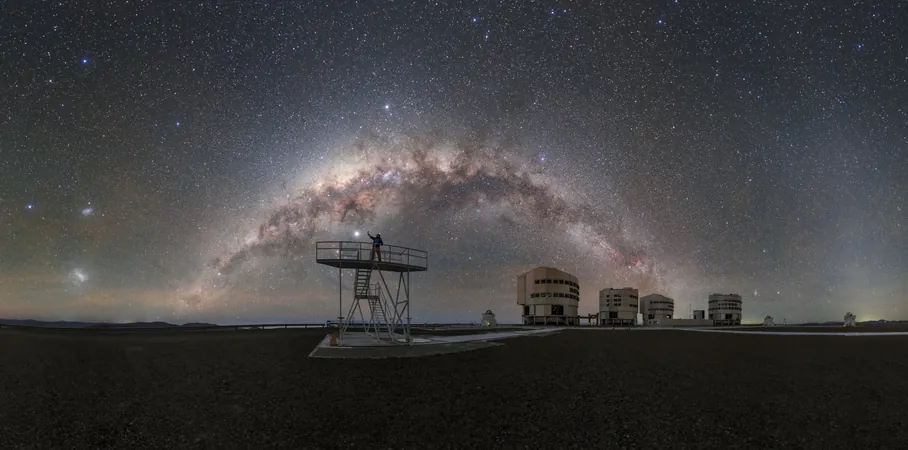
A Race Against Time: Protecting Earth's Last Frontier of Dark Skies from Industrial Threats!
2025-01-10
Author: Emma
A Race Against Time: Protecting Earth's Last Frontier of Dark Skies from Industrial Threats!
In a startling development, AES Andes, a subsidiary of the U.S. power giant AES Corporation, has recently submitted a controversial proposal for a massive industrial complex that poses a significant threat to the world's clearest and darkest skies over the renowned Paranal Observatory in Chile's Atacama Desert. This observatory is globally recognized for its pristine astronomical conditions and has been a beacon for groundbreaking cosmic discoveries since its opening in 1999.
The planned industrial project, alarmingly close—just 5 to 11 kilometers away from the observatory—could unleash irreversible light pollution and atmospheric disturbances that would severely compromise the quality of astronomical observations. Astronomers fear that the delicate balance of this unique environment will be destroyed if the project proceeds as planned, leading to a serious call for relocation to protect this invaluable natural heritage.
A Legacy of Cosmic Discoveries
Paranal Observatory, operated by the European Southern Observatory (ESO), has been pivotal in advancing our understanding of the universe. It played an instrumental role in capturing the first image of an exoplanet, which opened new chapters in the search for extraterrestrial life. Furthermore, groundbreaking research conducted there contributed to the 2020 Nobel Prize in Physics, awarded for discovering the supermassive black hole at the center of the Milky Way—an achievement that underscores the observatory's importance to global astronomical research.
Chile's astronomical community has burgeoned in recent years, attracting significant investment and talent, much of which is drawn to the Atacama Desert's unique conditions. Additionally, nearby, the ongoing construction of the Extremely Large Telescope (ELT)—set to be the largest telescope in the world—further emphasizes the importance of preserving the region’s dark skies for future exploration.
An Urgency to Act
"The AES Andes project represents a critical threat not only to Paranal but also to the future of astronomical research itself," warned Xavier Barcons, ESO Director General. "Dust from construction activities, enhanced atmospheric turbulence, and severe light pollution could jeopardize decades of investment and research."
With an industrial complex that spans over 3000 hectares—approximately the size of a sprawling Chilean city—plans include a port, production facilities for ammonia and hydrogen, and thousands of electricity generation units, all threatening to envelop the observatory in unnatural light.
A National and Global Responsibility
"It is crucial for the Chilean government and local stakeholders to explore alternative sites for AES Andes’s megaproject. We are standing at the crossroads of scientific progress and industrial development," stated Itziar de Gregorio, ESO's Representative in Chile. "The unique dark skies of Paranal are not just a national treasure; they are a global asset that benefits humanity as a whole.”
As the clamor for action grows, scientists advocate for immediate intervention. The relocation of this project emerges as the only viable solution to prevent devastating consequences to Paranal's unique dark skies, which remain crucial for unlocking the mysteries of our cosmos.
In a world increasingly dominated by light pollution, the preservation of these pristine skies has become a paramount mission. Will action be taken before it's too late? The future of astronomy—and perhaps our understanding of life in the universe—hangs in the balance.









 Brasil (PT)
Brasil (PT)
 Canada (EN)
Canada (EN)
 Chile (ES)
Chile (ES)
 Česko (CS)
Česko (CS)
 대한민국 (KO)
대한민국 (KO)
 España (ES)
España (ES)
 France (FR)
France (FR)
 Hong Kong (EN)
Hong Kong (EN)
 Italia (IT)
Italia (IT)
 日本 (JA)
日本 (JA)
 Magyarország (HU)
Magyarország (HU)
 Norge (NO)
Norge (NO)
 Polska (PL)
Polska (PL)
 Schweiz (DE)
Schweiz (DE)
 Singapore (EN)
Singapore (EN)
 Sverige (SV)
Sverige (SV)
 Suomi (FI)
Suomi (FI)
 Türkiye (TR)
Türkiye (TR)
 الإمارات العربية المتحدة (AR)
الإمارات العربية المتحدة (AR)